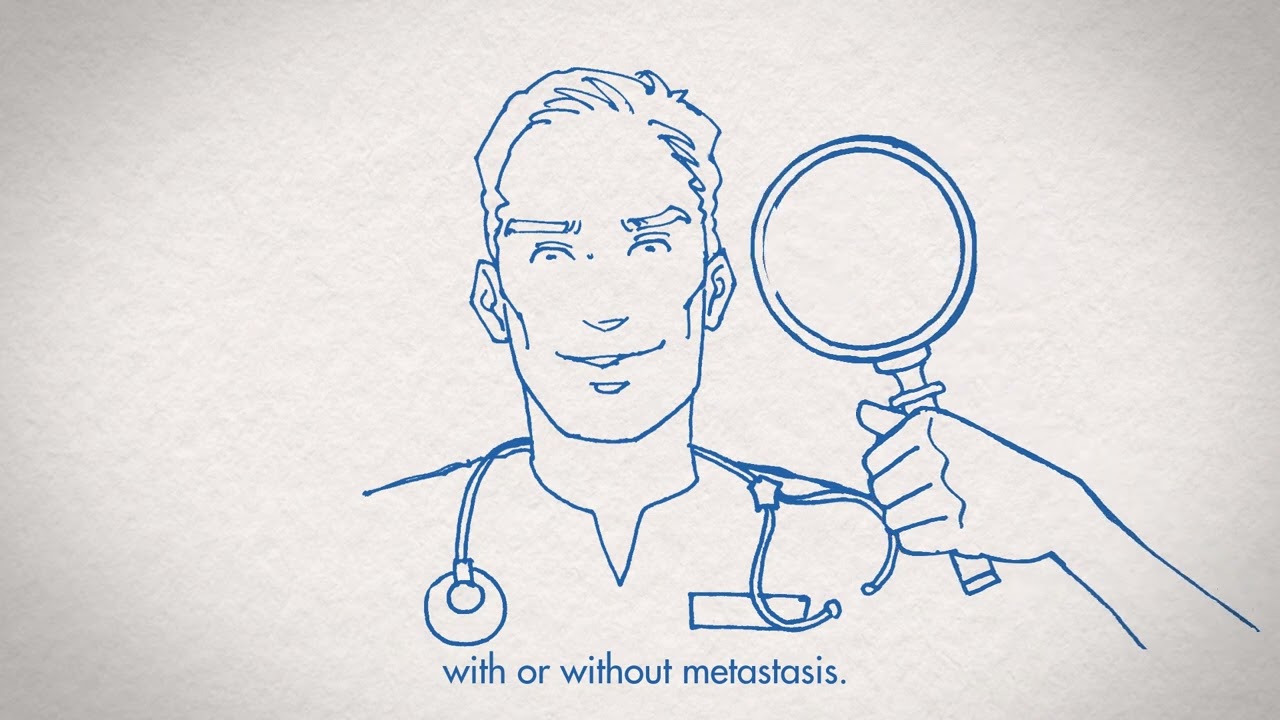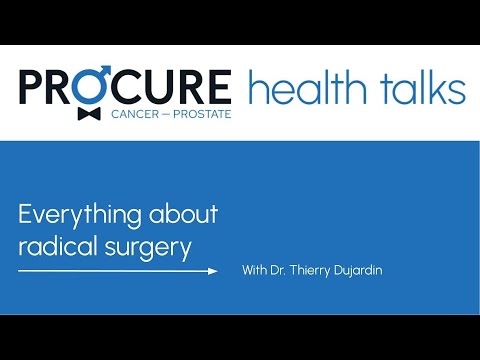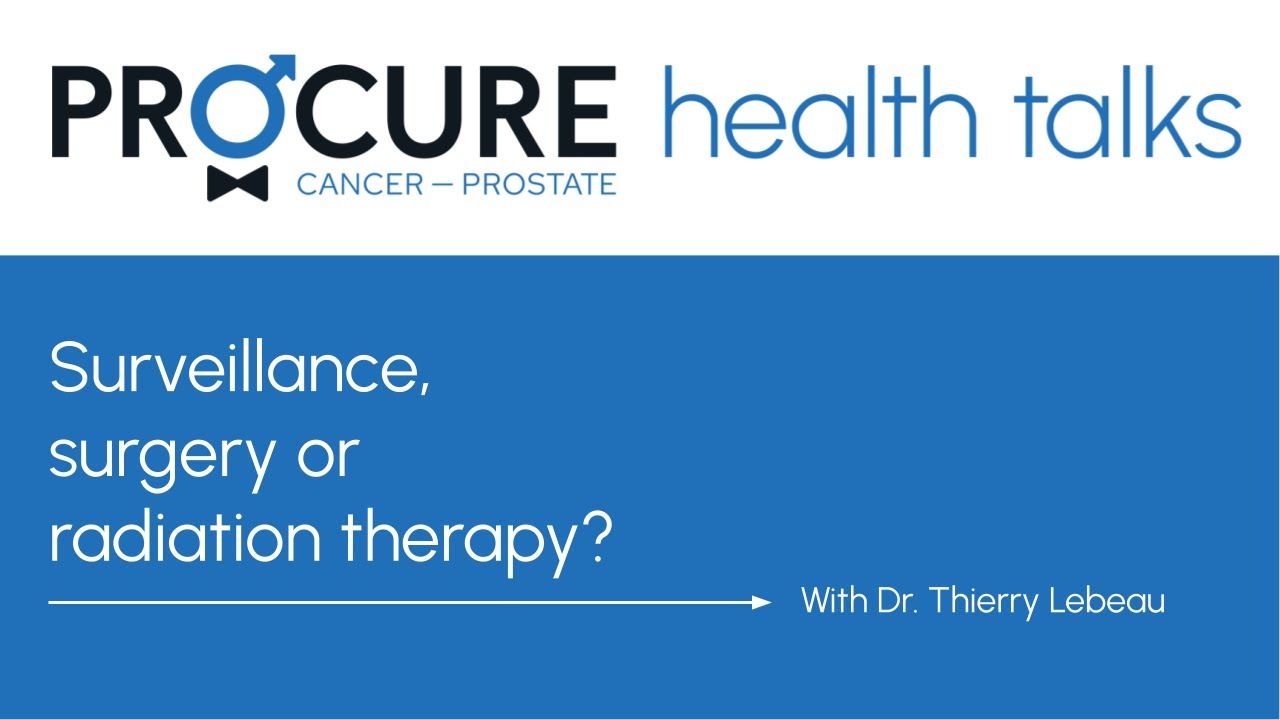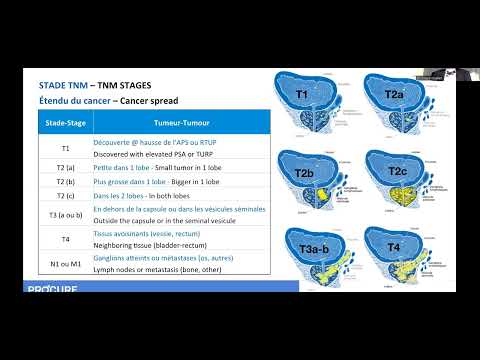Active surveillance
Active surveillance
Active surveillance
As surprising as it may seem, in some cases, if your cancer is confined within the prostate, your doctor may recommend waiting before you start treatment. He could opt for watchful waiting or active surveillance. There is a difference between the two approaches. Although we will address both approaches, the majority of the information on this page is about active surveillance, a treatment option for localized low-risk prostate cancer.

Active surveillance is a method of monitoring slow-growing prostate cancer rather than treating it immediately. The goal is to avoid unnecessary treatment or to delay treatment and potential side effects.
How does it work?
Often, prostate cancer progresses very slowly and may not cause symptoms, spread, or threaten your life for a long time. Active surveillance may be a treatment option if you have prostate cancer that is unlikely to progress significantly.
What does active surveillance involve?
While the term “active surveillance” may suggest inactivity, it is actually a dynamic program focused on closely monitoring cancer progression. Your healthcare team will carefully observe you and administer treatment if signs of tumor growth or an increased risk of cancer progression are detected.
Who is eligible for active surveillance?
Active surveillance may be offered if you have early-stage, low-grade cancer that is likely to grow slowly. This approach can help avoid the erectile dysfunction and incontinence risks associated with treatment (at least temporarily).
What is watchful waiting?
As mentioned earlier, watchful waiting is different from active surveillance. It is common for elderly men or those with slow-growing cancer and other significant health problems to die before the cancer becomes life-threatening.
When it is evident that your cancer will progress slowly and your life expectancy is less than 10 years, your doctor may prefer to wait until the disease manifests itself before starting treatment. This is called watchful waiting. In some cases, it is important to weigh the disadvantages of treatment against the risks posed by cancer.
Watchful waiting allows treatment to be initiated only when the cancer causes symptoms, to treat them. In this case, the goal of any future treatment will not be to cure your cancer but to manage your symptoms. This is referred to as palliative treatment.
If your doctor has recommended watchful waiting, your monitoring may include PSA testing, a physical examination, including a digital rectal exam (DRE), a bone scan, or other tests as needed, and if your cancer progresses, your doctor will address it. However, this approach varies case by case.
The decision to opt for active surveillance depends on various factors: your overall health, age, and family history. This option also depends on the aggressiveness of the cancer. Low-risk, well-differentiated cancers are generally less aggressive and slower to develop. Thus, active surveillance may be a treatment option if:
- Few samples are positive following your biopsy
- Your cancer is low-grade (Gleason score of 6), limited to your prostate
- Your PSA level is less than 10 ng/mL
- You have no symptoms
- You prefer not to undergo immediate treatment to avoid side effects and preserve your quality of life
Advantages and disadvantages
Advantages
- Avoids unnecessary treatments
- Avoids side effects
Disadvantages
- Frequent follow-up visits and tests
- Induces stress and anxiety in many patients
- Natural history of each patient’s cancer can differ
Risks and Complications
Although there are no tools that are 100% reliable for predicting disease progression, the risk of your cancer progressing to a more advanced stage or missing a treatment window is extremely rare due to your close monitoring. Your doctor will begin treatment once symptoms or signs of disease progression appear. The cure rate remains the same, and treatment after active surveillance is no more complicated or causes more side effects.

Regular tests
Regular tests will be done about every 3–6 months to monitor your prostate cancer. This can vary depending on your situation.
- Prostate-specific antigen (PSA) test
- Physical examination, including a digital rectal exam (DRE)
- Prostate biopsy
- Prostate MRI (in some cases)
Treatment if necessary
If your cancer is growing more quickly than expected or changes grades, your doctor may recommend active treatment (radical prostatectomy, radiation therapy, and/or hormone therapy).
Around 25–30% of men under active surveillance end up having to undergo treatment because of signs of cancer growth. The cure rate remains the same as if you had not had active surveillance.
Emotions you may feel
It is normal to worry about your cancer growing and spreading faster than expected. Some men may find it too stressful to have their prostate cancer watched or monitored without active treatment. For these men, immediate therapy may be the preferred option. If you have concerns, talk to your doctor.
What you can do
Think about your values
Most men with low-risk prostate cancer have time to think about their choices. These tips may help you reach a decision.
Discuss these questions with your spouse or partner:
- Do I want to get rid of my cancer, even if I might have sexual or urinary problems?
- Which side effects would upset me most?
- Would I be okay with active surveillance, even if I am worried and have to see the doctor more often?
Review your health history
- Give your cancer care team your full personal and family medical histories.
- Ask how your age and general health could affect treatment
- Ask if you have any condition that might increase the risks of treatment, for example, conditions such as diabetes, heart problems, or bowel disease might increase your risk of sexual, urinary, or bowel problems.
Learn
Find out all of your treatment options
Ask your doctors about each choice, including benefits and side effects. Some doctors only suggest the option they know best. Typically:
- a radiation oncologist can discuss active surveillance and radiation treatment.
- a urologist can discuss active surveillance and surgery.
Talk about your choices with these physicians and your family doctor.
Additional Information - Treatment options

Medical monitoring and care management
Are you undergoing treatment for prostate cancer? Various approaches can help monitor it.

Everything to know about radical surgery
Considering radical surgery for your cancer treatment? Watch this webinar to learn about the procedure, its benefits, drawbacks, and suitability for you.

Urinary and sexual problems after treatment
Prostate cancer treatments can lead to side effects, such as erectile dysfunction and urinary incontinence, which vary in intensity and duration.

Surveillance, surgery or radiation therapy?
Diagnosed with prostate cancer? Several treatment options are available based on the stage, age, and your health.

Active surveillance as a treatment option?
Did you know that in many cases it is not necessary to treat prostate cancer?

I was told about leaks, not incontinence
It is not uncommon to have calls from patients asking us why they suffer from incontinence following radical surgery to treat their prostate cancer.

I have 4 treatment options; confused, you say?
If being diagnosed with prostate cancer is a massive blow for men, the treatment options can quickly become a headache…

Active surveillance in 5 points
As surprising as it may seem, your doctor may prefer to wait before starting treatment.

Permanent brachytherapy: What exactly is it?
Permanent brachytherapy often called low dose rate brachytherapy, administers very small doses of radiation. They are emitted from small sources containing radioactive iodine, called “iodine 125”. These sources look like grains of rice. They stay in your prostate forever. However, their radioactivity decreases over time. After 6 months, 95% of the radioactivity has disappeared. The presence of these sources does not cause any long […]

Radical surgery: 5 points to remember
If you’ve been diagnosed with prostate cancer, your doctor will consider many factors before recommending the best treatment. For many of you, this may mean completely removing the prostate, which is radical surgery. Here are 5 points to remember if you are considering this option. Radical surgery: Is it for you? Radical surgery is the most common […]

Conventional or robotic surgery?
Here is a typical case of concern from a patient who has opted for radical surgery as a treatment for his cancer and who asks the famous question: Which surgery is better? Conventional or robotic surgery? Before answering it, let’s take a look at the context in which the question was asked of our nurses […]

Choice between radical surgery or radiotherapy?
Unless you are not a candidate for either option, there are generally no strict rules for deciding whether radical surgery or radiotherapy is preferable as a treatment. If your cancer is really confined to your prostate, it can be cured with surgery or radiation therapy. However, to benefit from a cure, your life expectancy must be […]

Recovery timeline after surgery
Recovery timeline after surgery, that is after radical prostate surgery, varies from person to person depending on how their body heals naturally and the severity of the disease before surgery. Here are some tips to help you with your recovery timeline. Plan your return home After surgery, you will not necessarily have the energy to […]

What is successful active surveillance
Is it possible to achieve successful active surveillance? Of course. Does this mean your cancer will never progress? Not at all. But in 65-70% of cases, cancer does not progress because the patient was a good candidate for this type of treatment option. Having prostate cancer does not necessarily mean that you will be treated. […]
Sources and references
Last medical and editorial review: April 2024. See our web page validation committee and our collaborators by clicking here.


